 Launch apps instantly. Claim $200 credits on DigitalOcean
Launch apps instantly. Claim $200 credits on DigitalOcean
A Complete Guide to Beas Kund Trek
Written by Adam Grace » Updated on: April 17th, 2024

Beas Kund Trek Overview:
Explore on a journey through the stunning landscapes of the Beas Kund Trek, where every step feels like a page turned in a nature's storybook. Nestled in the heart of the Himalayas, this trek is a mesmerizing blend of adventure and tranquillity. As you ascend, the lush greenery gradually gives way to snow-capped peaks, painting a picture-perfect scene that's straight out of a postcard.
The trek begins from the quaint town of Manali, leading you through dense forests, bubbling streams, and meadows adorned with vibrant wildflowers. Each twist and turn of the trail unveils a new marvel, captivating your senses and leaving you in awe of Mother Nature's grandeur.
But the real jewel awaits at Beas Kund, a serene glacial lake nestled amidst towering mountains. Here, amidst the pristine wilderness, you can't help but feel a profound sense of peace and awe-inspiring beauty. Whether you're a seasoned trekker or a novice adventurer, the Beas Kund Trek promises an unforgettable experience that'll leave you craving for more.
Beas Kund Trek Highlights:
1. Spectacular Scenery: The Beas Kund Trek unfolds like a living painting, with every step revealing a new masterpiece of nature. Traverse through dense forests alive with the chatter of birds and the rustle of leaves. As you ascend higher, the landscape transforms, offering sweeping vistas of snow-capped peaks piercing the clear blue sky. The meadows along the way are a riot of colors, carpeted with a kaleidoscope of wildflowers that dance in the gentle mountain breeze.
2. Beas Kund: The crown jewel of the trek, Beas Kund, is a sight to behold. Tucked away amidst towering mountains, this tranquil glacial lake exudes an otherworldly serenity. The crystal-clear waters mirror the surrounding peaks, creating a scene straight out of a fairytale. Sit by its shores, feel the crisp mountain air against your skin, and let the peaceful ambiance wash over you, rejuvenating your soul.
3. Adventure and Thrills: Brace yourself for an adrenaline-pumping adventure as you tackle the rugged terrain of the Himalayas. Cross gushing streams on makeshift bridges, navigate rocky paths carved into the mountainside, and conquer steep inclines that challenge both body and mind. Each twist and turn of the trail presents a new obstacle to overcome, pushing your limits and rewarding you with unmatched thrills and triumphs.
4. Cultural Encounters: The Beas Kund Trek isn't just about the landscape; it's also an opportunity to immerse yourself in the rich tapestry of local culture. Interact with the friendly villagers you encounter along the way, sharing stories and laughter over cups of steaming chai. Learn about age-old traditions passed down through generations, and gain insights into the deep connection between the people of Himachal Pradesh and their majestic surroundings.
5. Photography Paradise: For shutterbugs, the Beas Kund Trek is a dream come true. Every corner of this natural wonderland is a photo-worthy moment waiting to be captured. From majestic peaks piercing the clouds to delicate alpine flowers swaying in the breeze, the landscape offers an endless array of subjects to photograph. Whether you're a professional photographer or just snapping shots with your smartphone, you'll leave with memory cards filled with stunning images that will transport you back to the mountains whenever you look at them.
6. Manali Exploration: Extend your adventure by delving into the vibrant town of Manali. Lose yourself in its bustling markets, where colorful stalls offer everything from handcrafted souvenirs to aromatic spices. Indulge your taste buds with the delicious local cuisine, from piping hot momos to decadent Himachali thalis. And don't miss out on exploring the town's historical and cultural landmarks, such as the ancient Hadimba Temple and the peaceful Vashisht Hot Springs, each offering a glimpse into the rich heritage of this enchanting region.
How To Reach Beas Kund Trek:
To reach Manali, you have several options. If you prefer air travel, you can fly to Bhuntar Airport, also known as Kullu-Manali Airport, which is the nearest airport to Manali. Located in Bhuntar town, approximately 50 kilometers south of Manali, this airport offers regular flights from major cities like Delhi, Mumbai, and Chandigarh. From Bhuntar Airport, you can hire a taxi or take a bus to reach Manali, which takes about 2-3 hours by road. Alternatively, if you enjoy road trips, you can drive to Manali from nearby cities like Delhi, Chandigarh, or Shimla. From Delhi, you would take NH44 via Chandigarh, covering a distance of approximately 550 kilometers, which usually takes around 12-14 hours. From Chandigarh, the distance is approximately 310 kilometers, and the journey typically takes around 8-10 hours. Similarly, from Shimla, it's about 250 kilometers via NH205, with a journey time of around 7-8 hours. Whether you choose to travel by air, road, or car, each route offers its own unique experience, showcasing the beauty of the journey to Manali.
Things to do in Beas Kund Trek:
Warm Clothing: When it comes to clothing, think layers! Start with thermal innerwear to keep your body heat trapped close to your skin. Layer up with fleece jackets or sweaters for insulation, and top it off with a down jacket to shield yourself from biting winds. Don't forget to pack plenty of woollen socks to keep your feet warm and dry throughout the trek.
Sturdy Footwear: Your choice of footwear can make or break your trekking experience. Invest in sturdy, waterproof boots with good insulation and traction to navigate the icy terrain safely. Look for boots with ankle support to prevent injuries on uneven surfaces. Breaking in your boots before the trek is crucial to avoid blisters and discomfort along the way.
Sleeping Bag: A high-quality sleeping bag is your best friend during cold nights in the Himalayas. Opt for a sleeping bag rated for sub-zero temperatures to ensure a restful night's sleep. Consider bringing a sleeping bag liner for extra warmth and comfort. It's also a good idea to invest in a lightweight, compact sleeping bag that won't weigh you down during the trek.
Backpack: Your backpack is your lifeline on the trek, carrying all your essentials for survival. Choose a sturdy, waterproof backpack with padded shoulder straps and a hip belt for comfort. Look for one with multiple compartments to keep your gear organized and easily accessible. Pack essentials like water, snacks, extra layers of clothing, and personal items in your backpack, and don't forget to pack light to minimize strain on your back.
Headlamp or Flashlight: A reliable light source is essential for navigating in the dark, especially during early morning or late evening treks. Invest in a high-quality headlamp or flashlight with long battery life and adjustable brightness settings. Consider bringing extra batteries or a portable charger to ensure your light source doesn't fail when you need it most.
Water Bottle: Staying hydrated is key to staying healthy and energized during the trek. Bring a durable water bottle that won't freeze easily in cold temperatures. Consider using an insulated water bottle or storing your water bottle in an insulated sleeve to prevent freezing. Hydration packs are another convenient option for staying hydrated on the go.
Snacks: Fuel your trekking adventures with high-energy snacks like nuts, chocolate, energy bars, and dried fruits. Pack snacks that are lightweight, compact, and easy to eat on the move. Aim for a balance of carbohydrates, protein, and healthy fats to keep your energy levels up throughout the trek. Don't forget to pack extra snacks to share with your fellow trekkers and spread the joy!
Personal Medications: Be prepared for emergencies by bringing along any necessary medications and a basic first aid kit. Consider packing essentials like pain relievers, antidiarrheal medication, antiseptic wipes, bandages, blister pads, and insect repellent. If you have any pre-existing medical conditions, make sure to bring enough medication to last the duration of the trek and inform your trekking guide or group leader about your condition.
Sun Protection: Protect yourself from the harsh rays of the sun with sunscreen, sunglasses, and lip balm with SPF. Even in cold temperatures, the sun's rays can be intense at high altitudes, leading to sunburn and windburn. Apply sunscreen generously to exposed skin, including your face, neck, and hands, and reapply regularly throughout the day. Wear UV-protective sunglasses to shield your eyes from harmful UV rays and prevent snow blindness. Don't forget to protect your lips with a moisturizing lip balm that contains SPF to prevent chapping and sunburn.
Copyright © 2024 IndiBlogHub.com Hosted on Digital Ocean









Post a Comment
To leave a comment, please Login or Register